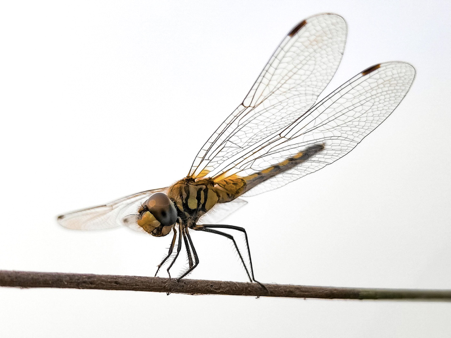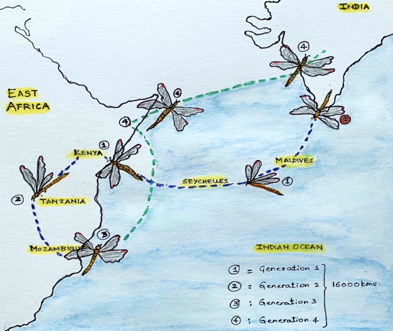
Dragonflies. That’s what’s possible.
Look out of the window, and if we are in Mumbai or in any monsoon/rainy areas of the country, we will spot plenty of dragonflies now, this very season. Over the last few weeks, watching large swarms from my window – hover, fly, change directions rapidly, mate in air, prey as well as become prey, has been my favourite pastime.
Imagine, they spend anywhere from five years to a few months in their larval stage in water, depending on whether they are in temperate or tropical waters (they are called nymphs in this stage), finally emerging to complete one last molting on a stem, and soon when all parts are developed, they become an adult just for a couple of weeks to eight weeks, maximum.
In just the two-eight weeks, that they show up for us to see them, they have been a muse to artists across the spectrum – inspiring poetry; jewellery; art; textile designs, technological wonders (drones), and more. I am yet to meet someone, who isn’t enamoured by the beauty and elegance of dragonflies.
If that’s not enough, one particular species who is just about two inches in size, holds the record for the longest intercontinental, multigenerational insect migration. Aptly named as Global Skimmer or Wandering Glider (Pantala favescens), they beat the record long held by the Monarch Butterflies.
Story of their Marvelous Migration:

These dragonflies come out of their larval stage as adults, around September, and are seen appearing in Kerala around the festival of Onam, and are called Ona-thumbi, or Dragonflies of Onam.
Since this particular species require moisture to reproduce, and freshwater to lay eggs, they follow the summer monsoon/rainfall from one continent to another. As India dries up around September, this first generation of adult dragonflies, fly the 400 miles across the Indian ocean, in millions, at an altitude of 1000-2000 metres, reaching Maldives, and continue beyond into Seychelles, finally getting to East Africa in about 4-5 days, in time for the rainfall there.
Let us pause here for a moment to visualize this beautiful tiny insect, flying about 2000 metres above sea level, across the mighty ocean, all the way from India to East Africa over four to five days? What an incredible feat.
They use the North East monsoon wind draft to carry them, along with their extremely well adapted wings that have a large surface area. Stroke-stroke-stroke and glide they go, being as energy efficient as possible.
And this is how the first generation of dragonflies reach East Africa where there is a short summer rain between Oct-November, breed, lay eggs in the rainwater pools, and in six weeks the second generation of dragonflies hatch, and continue flying further south of Africa, to Tanzania/Mozambique where the rains have moved. Here they breed again, lay eggs, and the third generation of dragonflies hatch, which fly back to East Africa in time for the long rains around Jan- April, where the fourth generation of dragonflies hatch, and this generation flies back to India by June in time for our monsoons, to breed, lay eggs, for the new cycle to emerge.
How, how, how, in the world does the second generation know where they need to fly, and the third generation, and then the fourth generation, making their way back to India, flying over the ocean, in time for our monsoons? That’s migration for us – the incredible animal adaptations, genetic remembrance, preparation, and inner guidance is simply astounding.
This intercontinental, multigenerational migratory circuit of about 16000 kilometres, is the longest insect migration recorded on Earth.
Curiosity piqued Dr. Charles Anderson, an independent biologist living in Maldives, in about 2009, when he noticed swarms of dragonflies each year, and by 2016 it was proven that Maldives is only a part of the migratory route, and so came the study of one of the most common dragonflies found globally, except in Antarctica. That we took so long to notice the ingenuity of this small creature, shows how many such marvelous wonders could still be in store for us to explore and discover!
On a side note, Dr. Charles Anderson also discovered, that engaging in the same migratory route, around the same time, were the following birds – cuckoos, nightjars, falcons, bee-eaters – and what did they all commonly feed on? Insects. In this case, dragonflies. Isn’t that enough goosebumps to see how every single being is so interconnected?
I wished to share this story, so you could all read, and right away admire the many dragonflies outside your windows, observe how they fly (each of their wings is controlled by an independent set of muscles), which makes them masters/miss, of flying forwards, backwards, sideways. Just try photographing them in their flight!
And if during your observations, you especially spot the Global Skimmer/Wandering Glider, maybe salute them, or if you have a loved one in Maldives, Seychelles, or East Africa, whisper something dear in their ears, that they can carry over generations to your loved one.
Coming back to my question – what is possible in a month or two?
Well, I for one, many a times move into this lovely rant, `oh, I do not have sufficient time, or I could have done this, completed that, worked on x, y, and what not’.
Really, Anjan?
If you feel similarly now and then, let us also gift ourselves the power of imagination and ask – What’s not possible, if what I engage in comes naturally to me, gives me meaning, and I move into it with discipline and perseverance?
We certainly cannot ask for a more beautiful, elegant, joyful creature, with angelic wings, to inspire us day after day with our work, and to pass it on, generation after generation, can we?
Thank you for reading.
If you have encountered Global Skimmers, please share your experience, photographs, and we can celebrate them together.
If this post evoked any other thoughts in you, I invite you to share them.
